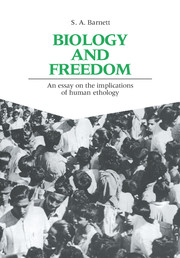Book contents
- Frontmatter
- Contents
- List of illustrations
- Preface
- Acknowledgements
- Part 1 An introduction
- Part 2 Homopugnax: the violent species
- Part 3 Homo egoisticus: the selfish species
- 6 Evolution and natural selection
- 7 Environment and heredity
- 8 Stories of human evolution
- 9 Darwinism, genetics and politics
- Part 4 Homo operans: the greedy species
- Part 5 Homo sapiens: the human species
- Glossary
- Notes
- References
- Name index
- Subject index
6 - Evolution and natural selection
Published online by Cambridge University Press: 04 August 2010
- Frontmatter
- Contents
- List of illustrations
- Preface
- Acknowledgements
- Part 1 An introduction
- Part 2 Homopugnax: the violent species
- Part 3 Homo egoisticus: the selfish species
- 6 Evolution and natural selection
- 7 Environment and heredity
- 8 Stories of human evolution
- 9 Darwinism, genetics and politics
- Part 4 Homo operans: the greedy species
- Part 5 Homo sapiens: the human species
- Glossary
- Notes
- References
- Name index
- Subject index
Summary
Vast chain of being! which from God began,
Nature's aetherial, human, angel, man,
Beast, bird, fish, insect, what no eye can see,
No glass can reach …
From Nature's chain whatever link you strike,
Tenth, or ten thousandth, breaks the chain alike.
Alexander Pope‘One hundred years ago’, a zoologist tells us, ‘Charles Darwin bequeathed to us a theory which is, in principle, able to explain every characteristic [of] every species.’ There are believed to be 3 to 30 million species of organisms, of which fewer than two million have been named and described. Each species has features that match it closely with a particular range of habitats or ways of living. If our descendants have the desire (and retain the resources), they will be able to spend millennia working on the systematics, distribution, life histories and physiology of known and as yet undescribed forms.
The all-embracing theory of Charles Darwin is that of natural selection; and it is an attempt to state how the diverse species of today have evolved. It must be distinguished from the quite separate proposition that organic evolution has indeed taken place: this states only that existing forms have arisen from very different forms in the past and that others will continue to do so in the future; it does not say anything about the agency, or agencies, of these vast changes.
- Type
- Chapter
- Information
- Biology and FreedomAn Essay on the Implications of Human Ethology, pp. 80 - 101Publisher: Cambridge University PressPrint publication year: 1989



